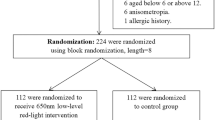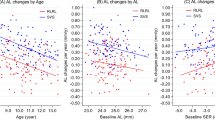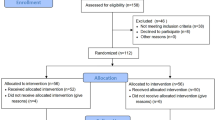Abstract
Purpose
To investigate the effect of low-intensity red-light (LRL) therapy on myopic control and the response after its cessation.
Methods
A prospective clinical trial. One hundred two children aged 6 to 13 with myopia were included in the LRL group (n = 51) and the single-focus spectacles (SFS) group (n = 51). In LRL group, subjects wore SFS and received LRL therapy provided by a laser device that emitted red-light of 635 nm and power of 0.35 ± 0.02 mW. One year after the control trial, LRL therapy was stopped for 3 months. The outcomes mainly included axial length (AL), spherical equivalent refraction (SER), subfoveal choroidal thickness (SFCT), and accommodative function.
Results
After 12 months of therapy, 46 children in the LRL group and 40 children in the SFS group completed the trial. AL elongation and myopic progression were 0.01 mm (95%CI: − 0.05 to 0.07 mm) and 0.05 D (95%CI: − 0 .08 to 0.19 D) in the LRL group, which were less than 0.39 mm (95%CI: 0.33 to 0.45 mm) and − 0.64 D (95%CI: − 0.78 to − 0.51 D) in the SFS group (p < 0.05). The change of SFCT in the LRL group was greater than that in the SFS group (p < 0.05). Accommodative response and positive relative accommodation in the LRL group were more negative than those in the SFS group (p < 0.05). Forty-two subjects completed the observation of LRL cessation, AL and SER increased by 0.16 mm (95%CI: 0.11 to 0.22 mm) and − 0.20 D (95%CI: − 0.26 to − 0.14 D) during the cessation (p < 0.05), and SFCT returned to baseline (p > 0.05).
Conclusions
LRL is an effective measure for preventing and controlling myopia, and it may also have the ability to improve the accommodative function. There may be a slight myopic rebound after its cessation. The effect of long-term LRL therapy needs to be further explored.
Trial registration
Chinese Clinical Trial Registry: Chinese Clinical Trails registry: ChiCTR2100045250. Registered 9 April 2021; retrospectively registered. http://www.chictr.org.cn/showproj.aspx?proj=124250




Similar content being viewed by others
Data availability
Datasets of this study are available from the corresponding authors upon reasonable request.
References
Pan CW, Ramamurthy D, Saw SM (2012) Worldwide prevalence and risk factors for myopia. Ophthalmic Physiol Opt 32:3–16. https://doi.org/10.1111/j.1475-1313.2011.00884.x
Holden BA, Fricke TR, Wilson DA et al (2016) Global prevalence of myopia and high myopia and temporal trends from 2000 through 2050. Ophthalmology 123:1036–1042. https://doi.org/10.1016/j.ophtha.2016.01.006
Ohno-Matsui K (2017) What is the fundamental nature of pathologic myopia? Retina 37:1043–1048. https://doi.org/10.1097/IAE.0000000000001348
Huang J, Wen D, Wang Q et al (2016) Efficacy comparison of 16 interventions for myopia control in children: a network meta-analysis. Ophthalmology 123:697–708. https://doi.org/10.1016/j.ophtha.2015.11.010
Cooper J, Tkatchenko AV (2018) A review of current concepts of the etiology and treatment of myopia. Eye Contact Lens 44:231–247. https://doi.org/10.1097/ICL.0000000000000499
Huang PC, Hsiao YC, Tsai CY et al (2020) Protective behaviours of near work and time outdoors in myopia prevalence and progression in myopic children: a 2-year prospective population study. Br J Ophthalmol 104:956–961. https://doi.org/10.1136/bjophthalmol-2019-314101
Yang X, Yang Y, Wang Y et al (2021) Protective effects of sunlight exposure against PRK-induced myopia in infant rhesus monkeys. Ophthalmic Physiol Opt 41:911–921. https://doi.org/10.1111/opo.12826
Rucker F (2019) Monochromatic and white light and the regulation of eye growth. Exp Eye Res 184:172–182. https://doi.org/10.1016/j.exer.2019.04.020
Zhu QR, Liu LQ (2021) [Relationship between myopia and light exposure]. Sichuan Da Xue Xue Bao Yi Xue Ban 52:901–906. https://doi.org/10.12182/20211160205
Hung LF, Arumugam B, She Z et al (2018) Narrow-band, long-wavelength lighting promotes hyperopia and retards vision-induced myopia in infant rhesus monkeys. Exp Eye Res 176:147–160. https://doi.org/10.1016/j.exer.2018.07.004
Jiang Y, Zhu Z, Tan X et al (2021) Effect of repeated low-level red-light therapy for myopia control in children: a multicenter randomized controlled trial. Ophthalmology S0161–6420:00916–00917. https://doi.org/10.1016/j.ophtha.2021.11.023
Xiong F, Mao T, Liao H et al (2021) Orthokeratology and low-intensity laser therapy for slowing the progression of myopia in children. Biomed Res Int 2021:8915867. https://doi.org/10.1155/2021/8915867
Zhou L, Xing C, Qiang W et al (2022) Low-intensity, long-wavelength red light slows the progression of myopia in children: an Eastern China-based cohort. Ophthalmic Physiol Opt 42:335–344. https://doi.org/10.1111/opo.12939
Ohlendorf A, Leube A, Wahl S (2016) Steps towards smarter solutions in optometry and ophthalmology-inter-device agreement of subjective methods to assess the refractive errors of the eye. Healthcare (Basel) 4:41
Antona B, Barra F, Barrio A et al (2009) Repeatability intraexaminer and agreement in amplitude of accommodation measurements. Graefes Arch Clin Exp Ophthalmol 247:121–127. https://doi.org/10.1007/s00417-008-0938-9
Yang Y, Wang L, Li P et al (2018) Accommodation function comparison following use of contact lens for orthokeratology and spectacle use in myopic children: a prospective controlled trial. Int J Ophthalmol 11:1234–1238. https://doi.org/10.18240/ijo.2018.07.26
Ma MM, Shi J, Li N et al (2019) Effect of vision therapy on accommodative lag in myopic children: a randomized clinical trial. Optom Vis Sci 96:17–26. https://doi.org/10.1097/OPX.0000000000001316
Felipe-Marquez G, Nombela-Palomo M, Cacho I et al (2015) Accommodative changes produced in response to overnight orthokeratology. Graefes Arch Clin Exp Ophthalmol 253:619–626. https://doi.org/10.1007/s00417-014-2865-2
Logan NS, Radhakrishnan H, Cruickshank FE et al (2021) IMI accommodation and binocular vision in myopia development and progression. Invest Ophthalmol Vis Sci 62:4. https://doi.org/10.1167/iovs.62.5.4
Rucker FJ, Wallman J (2008) Cone signals for spectacle-lens compensation: differential responses to short and long wavelengths. Vision Res 48:1980–1991. https://doi.org/10.1016/j.visres.2008.06.003
Wu H, Chen W, Zhao F et al (2018) Scleral hypoxia is a target for myopia control. Proc Natl Acad Sci USA 115:E7091–E7100. https://doi.org/10.1073/pnas.1721443115
Hamblin MR (2018) Mechanisms and mitochondrial redox signaling in photobiomodulation. Photochem Photobiol 94:199–212. https://doi.org/10.1111/php.12864
Francisco BM, Salvador M, Amparo N (2015) Oxidative stress in myopia. Oxid Med Cell Longev 2015:750637. https://doi.org/10.1155/2015/750637
Price H, Allen PM, Radhakrishnan H et al (2013) The Cambridge Anti-myopia Study: variables associated with myopia progression. Optom Vis Sci 90:1274–1283. https://doi.org/10.1097/OPX.0000000000000067
Mutti DO, Mitchell GL, Hayes JR et al (2006) Accommodative lag before and after the onset of myopia. Invest Ophthalmol Vis Sci 47:837–846
Koomson NY, Amedo AO, Opoku-Baah C et al (2016) Relationship between reduced accommodative lag and myopia progression. Optom Vis Sci 93:683–691. https://doi.org/10.1097/OPX.0000000000000867
Chen Y, Drobe B, Zhang C et al (2020) Accommodation is unrelated to myopia progression in Chinese myopic children. Sci Rep 10(1):12056. https://doi.org/10.1038/s41598-020-68859-6
Han X, Xu D, Ge W et al (2018) A comparison of the effects of orthokeratology lens, medcall lens, and ordinary frame glasses on the accommodative response in myopic children. Eye Contact Lens 44:268–271. https://doi.org/10.1097/ICL.0000000000000390
Pereira-da-Mota AF, Costa J, Amorim-de-Sousa A et al (2020) The impact of overnight orthokeratology on accommodative response in myopic subjects. J Clin Med 9:3687. https://doi.org/10.3390/jcm9113687
Woodman-Pieterse EC, Read SA, Collins MJ et al (2015) Regional changes in choroidal thickness associated with accommodation. Invest Ophthalmol Vis Sci 56:6414–6422. https://doi.org/10.1167/iovs.15-17102
Read SA, Fuss JA, Vincent SJ et al (2019) Choroidal changes in human myopia: insights from optical coherence tomography imaging. Clin Exp Optom 102:270–285. https://doi.org/10.1111/cxo.12862
Shinhmar H, Hogg C, Neveu M et al (2021) Weeklong improved colour contrasts sensitivity after single 670 nm exposures associated with enhanced mitochondrial function. Sci Rep 11:22872. https://doi.org/10.1038/s41598-021-02311-1
Jiménez R, Martínez-Almeida L, Salas C et al (2011) Contact lenses vs spectacles in myopes: is there any difference in accommodative and binocular function? Graefes Arch Clin Exp Ophthalmol 249:925–935. https://doi.org/10.1007/s00417-010-1570-z
Li Z, Cui D, Hu Y et al (2017) Choroidal thickness and axial length changes in myopic children treated with orthokeratology. Cont Lens Anterior Eye 40:417–423. https://doi.org/10.1016/j.clae.2017.09.010
Li Z, Hu Y, Cui D et al (2019) Change in subfoveal choroidal thickness secondary to orthokeratology and its cessation: a predictor for the change in axial length. Acta Ophthalmol 97:e454–e459. https://doi.org/10.1111/aos.13866
Jiang Y, Zhang Z, Wu Z et al (2021) Change and recovery of choroid thickness after short-term application of 1% atropine gel and its influencing factors in 6–7-year-old children. Curr Eye Res 46:1171–1177. https://doi.org/10.1080/02713683.2020.1863431
Tong L, Huang XL, Koh AL et al (2009) Atropine for the treatment of childhood myopia: effect on myopia progression after cessation of atropine. Ophthalmology 116:572–579. https://doi.org/10.1016/j.ophtha.2008.10.020
Chia A, Chua WH, Wen L et al (2014) Atropine for the treatment of childhood myopia: changes after stopping atropine 0.01%, 0.1% and 0.5%. Am J Ophthalmol 157:451-457.e1. https://doi.org/10.1016/j.ajo.2013.09.020
Chia A, Lu QS, Tan D (2016) Five-year clinical trial on atropine for the treatment of myopia 2: myopia control with atropine 0.01% eyedrops. Ophthalmology 123:391–399. https://doi.org/10.1016/j.ophtha.2015.07.004
Acknowledgements
The authors thank the corporation of LONGDA who provided the low-intensity red-light therapy device. Additionally, the authors gratefully acknowledge the ophthalmic technicians who helped conducted this trail at the First People’s Hospital of Xuzhou. Finally, the authors sincerely acknowledge the families and children who participated in this study.
Funding
This study supported by the Xuzhou Medical Leading Talent Training Project (Grant No.XWRCHT20210022) and Development Fund Project of Affiliated Hospital of Xuzhou Medical University (Grant No.XYFM2020028).
Author information
Authors and Affiliations
Contributions
HYC, WW, and XJW conceived the research ideas. HYC, YL, WZ, and QL performed the experiments. JJW, JT, and YFP analyzed the data. HYC, WW, and XJW wrote the manuscript. All authors contributed to manuscript revision, and each read and approved of the final manuscript.
Corresponding author
Ethics declarations
Ethics approval and consent to participate
Our study and protocol conformed to the principles of the Declaration of Helsinki and were approved by the ethical committee of The First People’s Hospital of Xuzhou (Number: 2020-KY-075).
Consent for publication
All study subjects gave informed consent.
Conflict of interest
The authors declare no competing interests.
Additional information
Publisher's note
Springer Nature remains neutral with regard to jurisdictional claims in published maps and institutional affiliations.
Supplementary Information
Below is the link to the electronic supplementary material.
Rights and permissions
Springer Nature or its licensor holds exclusive rights to this article under a publishing agreement with the author(s) or other rightsholder(s); author self-archiving of the accepted manuscript version of this article is solely governed by the terms of such publishing agreement and applicable law.
About this article
Cite this article
Chen, H., Wang, W., Liao, Y. et al. Low-intensity red-light therapy in slowing myopic progression and the rebound effect after its cessation in Chinese children: a randomized controlled trial. Graefes Arch Clin Exp Ophthalmol 261, 575–584 (2023). https://doi.org/10.1007/s00417-022-05794-4
Received:
Revised:
Accepted:
Published:
Issue Date:
DOI: https://doi.org/10.1007/s00417-022-05794-4




